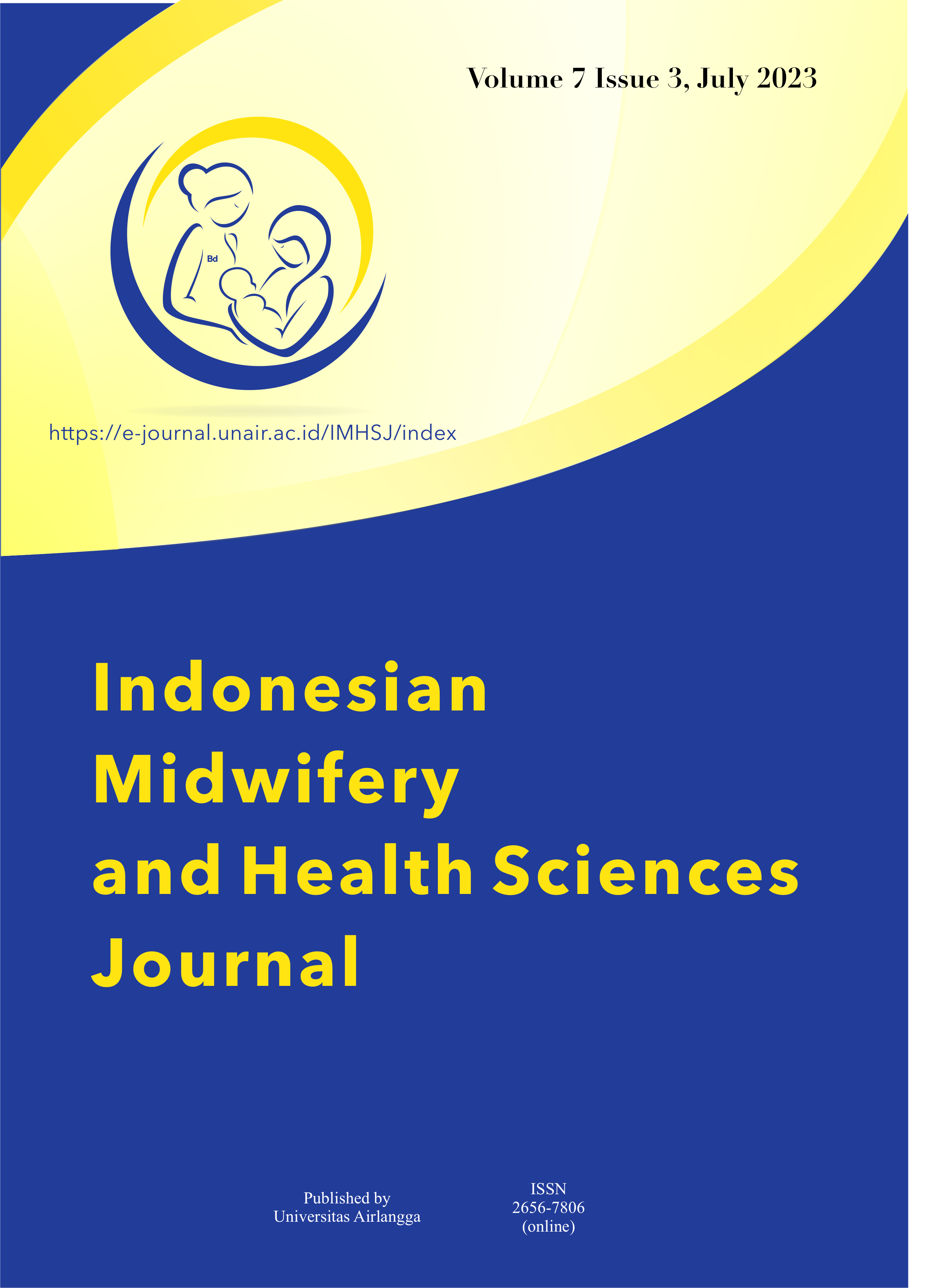RISK FACTORS ASSOCIATED WITH POSTPARTUM OBSTETRIC DANGER SIGNS

Downloads
Backgrounds: The postpartum period is approximately 40-42 days after giving birth, during which time there is a risk of complications for the mother. However, this is not realized by the mother because the main focus is caring for the baby. Therefore, mothers and families need to know the causes of the risk of postpartum danger. The purpose of this study was to determine the factors that cause danger signs during the puerperium so that appropriate and fast treatment doing. Method: The research design is analytic with a cross sectional approach. The study involved 70 postpartum and total sampling was based on age, knowledge, and family support. The results of the chi-square statistical test showed that there was a relationship between postpartum danger signs and education (p value = 0.003 OR = 6.413), knowledge (p value = 0.020, OR = 4.773) and family support (p value = 0.040, OR = 3.838). The result of the age variable is that there is no relationship (p value = 0.967 OR = 1.202). Conclusion: Postpartum based on their level of education, good knowledge and husband's support are able to detect danger signs during the postpartum so that the mother and baby are healthy.
Keywords: Risk factors obstetric, postpartum
Bobak, Lowdermilk, Jensen. (2016). Buku Ajar Keperawatan Maternitas. Jakarta: EGC
Desfanita, Misrawati, Arneliwati. (2015). Faktor-Faktor Yang Mempengaruhi Postpartum Blues. JOM; Vol 2(2). Hal: 999-1006
Dennis et al. (2007). Traditional postpartum practices and rituals: a qualitative systematic review. Women's Health, 3 (4), 487-502.
Dinas Kesehatan Provinsi DKI Jakarta. (2021). Profil Kesehatan Provinsi DKI Jakarta. Jakarta: Dinas Kesehatan Provinsi DKI Jakarta
Haksari, E.L., dan Surjono, A. (2001). Risiko kematian perinatal pada primipara di lima Rumah Sakit Daerah Tingkat II di Yogyakarta. Berkala Ilmu Kedokteran, 33 (4)
Hung Hsiu. (2011). Predictors of postpartum stress. J Clin Nurs. Vol. 20 (5-6): 666-674
Jacob, S., & Sujatha, R. (2013). An exploratory study on knowledge and attitude of fathers towards breastfeeding in selected hospitals at Mangalore. International Journal of Nursing Education, 5(1), 213-217. 10.5958/j.0974-9357.5.1.051
Kemenkes RI. (2019). Panduan Pelayanan Pasca Bagi Ibu dan BayiBaru Lahir. Jakarta: Kemenkes RI
Manuaba IAC, Manuaba IBG, Manuaba IBGF, Manuaba IBG (2014). Ilmu kebidanan, penyakit kandungan, dan kb untuk pendidikan bidan. Edisi ke 2. Jakarta: EGC, 2014:247-254
Mas'adah.(2010). Hubungan Antara Kebiasaan Berpantang Makanan Tertentu Dengan Penyembuhan Luka Perineum Pada Ibu Nifas.Jurnal Penelitian Kesehatan suara Forikes.Jurusan Kebidanan Poltekes Kemenkes Surabaya
Mattea Romano. (2010). Postpartum Period: Three Distinct But Continuous Phases. J Prenat Med. Vol. 4(2): 22–25.
Mudatsir, M. (2017). Faktor Budaya Dalam Perawatan Ibu Nifas. Jurnal Ilmu Keperawatan,5(1), 36–49.
Nugroho, Buku Ajaran Asuhan Kebidanan 3 Nifas. Yogyakarta: Nuha Medika, 2014.
Pitriani, Risal. 2014. Asuhan Kebidanan Ibu Nifas Normal (Askeb III ). Deepublish: Yogyakarta
Rachmawati, Marcelina, Permatasari. (2021). Hubungan Dukungan Sosial Dengan Self-Efficacy Ibu Postpartum. JKEP. Vol 6 (2). Hal: 160-172
Rahayu, Rosita. (2020). Analisis Pengetahuan Ibu Nifas Tentang Tanda Bahaya Masa Nifas Terhadap Pemanfaatan Buku Kia Di Rsu Budi Kemuliaan. Medikes (Media Informasi Kesehatan. Vol. 7 (2): 396-402
Rempel, L. A., & Rempel, J. K. (2012). The breastfeeding team: The role of involved fathers in the breastfeeding family. Journal Human Lactation, 27(2), 115-121.
Saifuddin, Buku Acuan Nasional Pelayanan Kesehatan Maternal neonatal. Jakarta: YBPSP, 2009.
Sarwono Prawirohardjo. 2016. Ilmu kebidanan. Jakarta : PT. Bina Pustaka Sarwono Prawirohardjo
Walyani and Purwoastuti, Asuhan Kebidanan Masa NIfas dan Menyusui. Yogyakarta: PT Pustaka Baru, 2015
WHO. (2019). Maternal mortality: Levels and trends 2000 to 2017. Available from: https://www.who.int/reproductivehealth/publications/maternal-mortality-2000-2017/en
Yanti and Sundawati, Asuhan Kebidanan Masa Nifas. Bandung: Refika Aditama, 2014
Copyright (c) 2023 erik ekowati, Nina Herlina

This work is licensed under a Creative Commons Attribution-ShareAlike 4.0 International License.
1. The journal allows the author to hold the copyright of the article without restrictions.
2. The journal allows the author(s) to retain publishing rights without restrictions
3. The formal legal aspect of journal publication accessibility refers to Creative Commons Atribution-Share Alike 4.0 (CC BY-SA).
This Journal (e-ISSN 2656-7806) is licensed under a Creative Commons Attribution-ShareAlike 4.0 International License.
















